Bolex H16 User
For Practical Bolex H16 Filming
Bolex Professional
Bolex Product Code:- ???
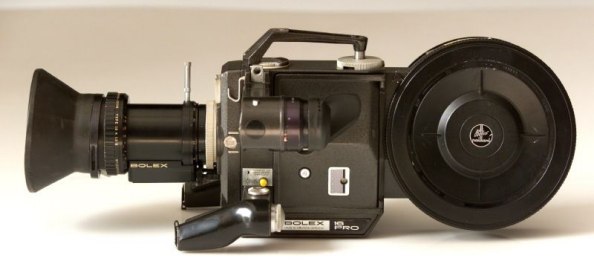 The
Bolex PRO 16 camera, was especially designed for ultra-portable newsreel
and reportage sync shooting. It Adopts a radically new layout and drive
system from other Bolex cameras.
The
Bolex PRO 16 camera, was especially designed for ultra-portable newsreel
and reportage sync shooting. It Adopts a radically new layout and drive
system from other Bolex cameras.
It is extremely silent in use and, additionally, offers the professional several features which while they had been common in amateur equipment at the time had not been seen in professional equipment before.
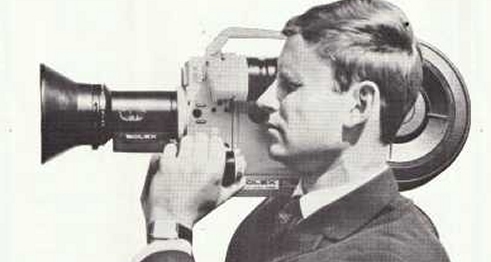 These
include servo lens control of iris, focal length and focus i.e. power
zoom and focus. Another feature is automatic threading.
These
include servo lens control of iris, focal length and focus i.e. power
zoom and focus. Another feature is automatic threading.
The PRO 16 consists of two basic units: the camera body, incorporating the lens mount and servo mechanisms, with clip on magazine and a separate power pack and control unit.
The camera is shaped to sit on the shoulder and all controls are on two handgrips on either side. Extensive use is made of electronics for controlling the main drive motor as well as the servos, using plug in modules encapsulated in silicon rubber.
High Efficiency Motor
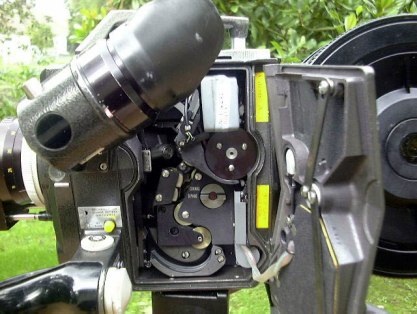 The
drive system is particularly interesting. The motor has been dubbed by
Bolex as the "Synchro-Vario" i.e. synchronous at variable speeds.
It is said to combine the high starting torque of a series, the controllability
of a shunt and the load independent speed stability of a synchronous motor,
no slip rings or commutators are needed, and an efficiency equal to the
best commutator types of similar size claimed.
The
drive system is particularly interesting. The motor has been dubbed by
Bolex as the "Synchro-Vario" i.e. synchronous at variable speeds.
It is said to combine the high starting torque of a series, the controllability
of a shunt and the load independent speed stability of a synchronous motor,
no slip rings or commutators are needed, and an efficiency equal to the
best commutator types of similar size claimed.
The design uses a permanent-magnet rotor driven by a three-phase stator; this is controlled via an oscillator, whose frequency can be varied to give constant running speeds between 12 and 50fps; alternatively, it can be locked to an external control signal - mains, pilot tone, crystal drive etc.
A pilot tone output for synchronising to an external tape recorder is provided and, with the sync cable plugged in, the camera will put an automatic start mark on to the film by flogging a frame.
Instant Full Speed
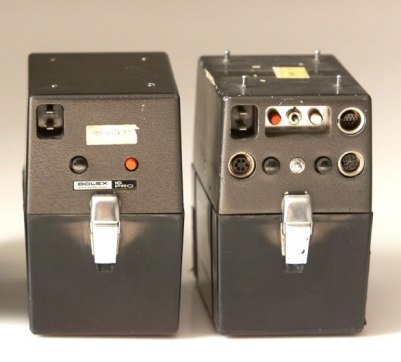 A
feedback system is used in the power drive stage, which ensures that the
motor comes up to full speed in a fraction of one revolution; there is
also instant magnetic braking when the camera is stopped.
A
feedback system is used in the power drive stage, which ensures that the
motor comes up to full speed in a fraction of one revolution; there is
also instant magnetic braking when the camera is stopped.
A memory circuit ensures that it stops with the claw engaging a perforation half way through the pull down cycle, so that the mirror shutter diverts lights to the finder (no annoying blackouts here). Yet the run up is so fast that even the first frame is correctly exposed, thus, there are no flash frames, the camera can be switched to give single frame operation for animation, time lapse and so on.
This remarkable performance can only be achieved by allowing the motor to draw a fairly high starting current and, for this reason, Bolex have chosen a (spill proof) lead acid battery, this is housed with the electronic components and a universal charger (which can be plugged in without adjustment to any 110-240v ac supply) in a 11lb unit slung from the shoulder. It is understood that an alternative nickel cadmium power pack is being developed.
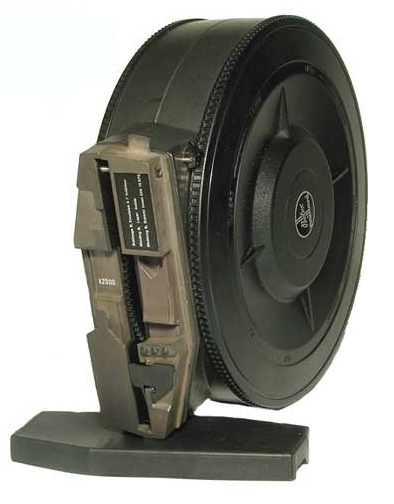 The
film cassette takes the form of a drum housing the 400ft feed and take
up chambers side by side on a common axis. Film on spools or cores can
be used, while the take up side contains a device that automatically attaches
the film to the core when the end is fed into the mouth of the chamber.
The cassette contains one way clutches to permit forward / reverse running,
and a couple of rollers form loops that act as light traps. There are
no other components (such as friction drive or sprockets) in the cassette,
thus keeping both size and noise to minimum.
The
film cassette takes the form of a drum housing the 400ft feed and take
up chambers side by side on a common axis. Film on spools or cores can
be used, while the take up side contains a device that automatically attaches
the film to the core when the end is fed into the mouth of the chamber.
The cassette contains one way clutches to permit forward / reverse running,
and a couple of rollers form loops that act as light traps. There are
no other components (such as friction drive or sprockets) in the cassette,
thus keeping both size and noise to minimum.
In the prototype which was previewed at the photonika photographic exhibition, the cassettes were made of high impact black plastic. It is understood, however that among the changes made for the production model is a switch to light alloy for the cassettes. Due to the need to discipline the film side ways between the two halves, the cassette is fitted to the camera body at a slight angle; this, in fact gives an improved fit to the head and shoulder of the operator. The cassette layout more or less determines the film path through the camera, it takes the form of a closed loop through the camera gate.
The feed and take up sprockets are placed side
by side on a common shaft at the rear of the body, with a slipping clutch
drive to the magazine between them. This allows a particularly simple
mechanical ![]() layout,
with only two shafts used, one of which is the motor shaft. With such
a versatile motor, there is no need for externally mounted interchangeable
motors for various purposes as is the case for most other Bolex cameras.
layout,
with only two shafts used, one of which is the motor shaft. With such
a versatile motor, there is no need for externally mounted interchangeable
motors for various purposes as is the case for most other Bolex cameras.